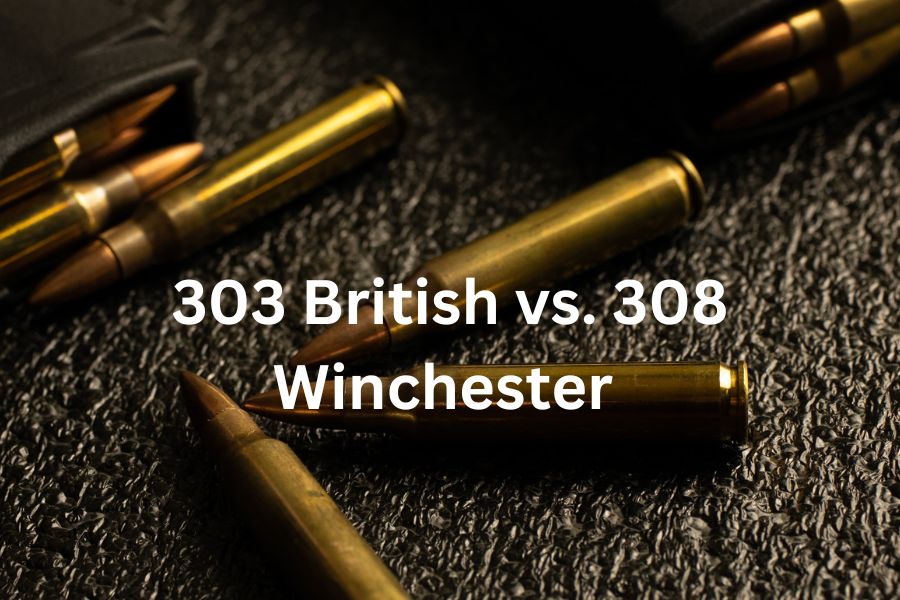When it comes to comparing different types of ammunition, it’s important to consider factors such as accuracy, velocity, and stopping power. In this article, we’ll take a closer look at the 303 British and the 308 Winchester, two popular cartridges that have been used for hunting and military purposes for many years.
Here is the short answer:
The 308 Winchester has the same ballistic performance and the same amount of recoil as the 303 Brtish. However, the 308 Winchester is far more popular and is not only chambered in more rifles, it also costs less per round to shoot.
Now that we have looked at the short answer, we can look in-depth at each cartridge, their ballistics, and how they compare in-depth.
In-Depth Look at the 303 British
The 303 British cartridge is a caliber that has been deeply embedded in the history of rifle cartridges and continues to be utilized even today. In 1888, it was designed by British military forces with the aim of responding to emerging smokeless powder technology and supplanting their current black powder rounds. The .303 saw use in many weapons stemming from Britain’s army during both World War I and II until they eventually switched out for the 5.56x45mm NATO round.
The 303 British is known for its stopping power, which makes it a popular choice for hunting larger game such as moose and elk. It’s also a popular choice for military applications, as it was used in the famous Lee-Enfield rifle during World War I and World War II. While the 303 British has been largely replaced by more modern cartridges, it’s still a favorite among some hunters and military enthusiasts.
Here is a ballistics chart of the 303 British with a 150-grain bullet:
| range (YD) | drop (IN) | wind drift (IN) | velocity FPS | energy ft-lb |
| 0 | -1.5 | 0 | 2690 | 2410 |
| 50 | -0.1 | 0.2 | 2565 | 2190 |
| 100 | 0 | 0.9 | 2442 | 1987 |
| 150 | -1.4 | 2.2 | 2324 | 1798 |
| 200 | -4.4 | 4.1 | 2208 | 1624 |
| 250 | -9.2 | 6.6 | 2096 | 1463 |
| 300 | -15.9 | 9.7 | 1988 | 1316 |
| 350 | -24.7 | 13.3 | 1881 | 1179 |
| 400 | -36.1 | 18 | 1780 | 1055 |
| 450 | -50.5 | 23.6 | 1683 | 943 |
| 500 | -67.8 | 30 | 1590 | 842 |
In-Depth Look at the 308 Winchester
The .308 Winchester is an extremely popular choice for hunters, military personnel, law enforcement officers, and target shooters alike due to its excellent performance capabilities at long ranges as well as close quarters combat situations. It has been found suitable for both hunting medium-sized game such as deer or wild boar up to large animals like moose or bear with appropriate loads selected by experienced sportsmen depending on their individual needs; likewise, it can be used effectively against targets out past 500 yards when properly zeroed into account wind direction conditions.
Here is a ballistics chart of the 308 Winchester with a 150-grain jacketed soft point:
| range (YD) | drop (IN) | wind drift (IN) | velocity FPS | energy ft-lb |
| 0 | -1.5 | 0 | 2820 | 2648 |
| 50 | -0.1 | 0.3 | 2673 | 2380 |
| 100 | 0 | 1.1 | 2532 | 2134 |
| 150 | -1.2 | 2.4 | 2394 | 1909 |
| 200 | -3.9 | 4.4 | 2261 | 1702 |
| 250 | -8.4 | 7.1 | 2132 | 1514 |
| 300 | -14.7 | 10.4 | 2007 | 1341 |
| 350 | -23.1 | 14.6 | 1886 | 1184 |
| 400 | -34.2 | 19.7 | 1771 | 1044 |
| 450 | -48.1 | 25.9 | 1661 | 919 |
| 500 | -65 | 32.9 | 1557 | 807 |
In-Depth Comparison
When it comes to comparing the ballistics of the 303 British to the 308 Winchester these two cartridges are practically identical. They have pretty much the same energy, the same drop, the same wind drift, and the same velocity.
Another major difference between the two cartridges is their availability. The 303 British is an older cartridge that has died out in recent years and can be hard to find. On the other hand, the 308 Winchester is a popular cartridge that is used by many different military and civilians around the world
When it comes to recoil, the 303 British has slightly less recoil. The 303 British has about 15 foot-pounds of recoil while the 308 Winchester has 15-18 foot-pounds of recoil. However, the difference is so small, that most shooters should not worry about it.
Conclusion
When it comes to choosing between the 303 British and the 308 Winchester the winner is the 308 Winchester. The 308 Winchester has the same ballistic performance as the 303 British but is far easier to find and costs less money.

